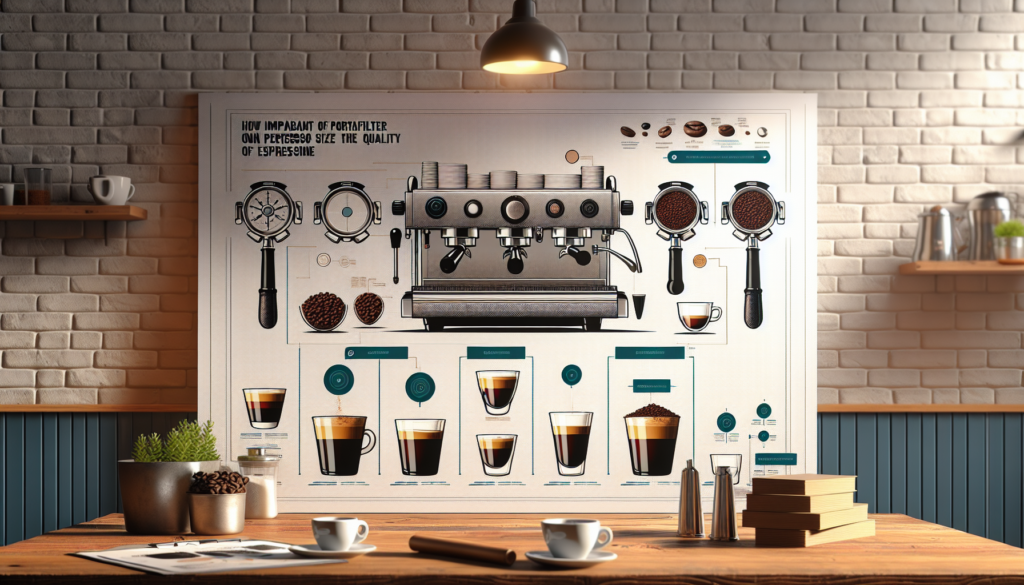
Are you a coffee enthusiast who loves the art of brewing espresso at home? If so, you might have wondered about the significance of portafilter size in stainless steel espresso machines. In this article, we will explore how the size of the portafilter impacts the quality of your espresso. So, grab your favorite cup of joe and get ready to uncover the secrets behind achieving the perfect espresso shot.

The Importance of Portafilter Size
When it comes to making a great espresso, the size of the portafilter plays a crucial role. The portafilter is the metal basket that holds the coffee grounds and is attached to the espresso machine. In this article, we will dive deep into understanding the role of the portafilter in espresso extraction and how its size affects the overall extraction process. We will also explore the relationship between portafilter size and espresso quality, as well as provide insights into choosing the right portafilter size for your espresso machine.
Different Sizes of Portafilters
Portafilters come in a variety of sizes, but there are a few common ones used in stainless steel machines. The most popular sizes are 53mm, 58mm, and 61mm. Each size has its own advantages and disadvantages. Smaller portafilters, such as the 53mm, are often found in compact espresso machines or those designed for single servings. They require less coffee grounds, making them more economical for personal use. On the other hand, larger portafilters like the 58mm and 61mm are commonly found in commercial espresso machines, allowing for a higher volume of espresso to be brewed at once.
Choosing the right portafilter size for your espresso machine depends on several factors. If you have a compact machine or are only making espresso for yourself, a smaller portafilter may be sufficient. However, if you entertain guests frequently or work in a cafe setting, a larger portafilter is recommended to ensure you can handle higher demands. It’s important to consider both the intended usage and the capacity of your espresso machine when selecting the appropriate portafilter size.
Extraction Consistency and Portafilter Size
One of the essential factors in achieving a great espresso is consistency in the extraction process. The size of the portafilter plays a significant role in this consistency. A larger portafilter allows for a more even distribution of coffee grounds, leading to a more consistent extraction. This is because the larger surface area allows the water to pass through the grounds more evenly, extracting the flavors uniformly.
On the other hand, using a smaller portafilter may lead to an uneven extraction. The smaller surface area means that water has a harder time passing evenly through the coffee grounds, resulting in potential under-extraction or over-extraction of certain areas. However, with proper technique and adjustments, it is still possible to achieve consistent results with smaller portafilters. Factors such as tamping pressure and distribution techniques become particularly important when working with a smaller surface area.
To ensure uniformity in particle extraction and elevate the overall quality of your espresso, it is generally recommended to use a larger portafilter whenever possible. However, if you are using a smaller portafilter, focusing on your tamping technique, distribution methods, and adjusting your grind size can help compensate for the reduced surface area and promote more consistent extraction.
Brewing Variables and Portafilter Size
When understanding the impact of portafilter size on espresso quality, it’s essential to consider its interaction with other brewing variables. Two crucial variables are grind size and dose. Grind size refers to how finely or coarsely the coffee beans are ground, while dose refers to the amount of coffee grounds used in the portafilter.
Different portafilter sizes may require adjustments to the grind size and dose to achieve optimal extraction. A larger portafilter may benefit from a slightly coarser grind and a higher dose, whereas a smaller portafilter may require a finer grind and a lower dose. These adjustments can help balance the extraction and ensure you are extracting the flavors you desire from your coffee.
Experimentation is key when it comes to finding the right balance between portafilter size, grind size, and dose. It is recommended to start with a baseline and make small adjustments until you achieve the desired extraction. Keep in mind that changes in one variable may require adjustments in others to maintain consistency. Fine-tuning these brewing variables will help you optimize the extraction process for each portafilter size and ultimately enhance the quality of your espresso.

Pressure and Flow Rate
The size of the portafilter also affects the pressure and flow rate of the water during extraction. In an ideal extraction, the water should pass through the coffee grounds at a consistent pressure and flow rate. A larger portafilter allows for a smoother flow, as the water has more room to pass through the coffee grounds. This can contribute to a more balanced extraction, capturing the desired flavors and aromas.
On the contrary, a smaller portafilter may result in a restricted flow rate, which can lead to uneven extraction. The reduced surface area causes the water to flow through the coffee grounds more slowly and potentially unevenly. This can result in over-extracted or under-extracted areas of the coffee puck, affecting the overall quality of the espresso.
To balance pressure and flow rate for optimal extraction, it is important to adjust variables such as grind size, dose, and tamping pressure. The goal is to ensure that the water flows evenly through the coffee grounds, extracting the flavors consistently. Experimentation and practice are key to finding the optimal combination of brewing variables for each portafilter size and achieving a well-balanced extraction.
Effects on Crema and Body
Crema, the golden layer of foam on top of an espresso shot, is highly prized by coffee enthusiasts. The size of the portafilter can influence the formation and quality of crema. A larger portafilter allows for a more uniform extraction, which can contribute to the creation of a thick and creamy crema. The increased surface area allows the coffee oils and compounds to mix more thoroughly with the water, creating a desirable layer of crema.
In contrast, a smaller portafilter may result in a thinner or less pronounced crema. The restricted surface area restricts the interaction between the water and coffee oils, potentially leading to a less developed crema. However, it is essential to note that crema is not the sole indicator of espresso quality, and a thinner crema does not necessarily mean inferior taste.
The body and mouthfeel of espresso are also influenced by the size of the portafilter. A larger portafilter allows for a more complete extraction of oils and compounds, resulting in a fuller-bodied espresso with a richer mouthfeel. On the other hand, a smaller portafilter may yield a lighter-bodied espresso.
Ultimately, the desired crema and body are subjective and depend on personal preference. Experimenting with different portafilter sizes can help you discover your preferred balance of crema thickness and espresso body to enhance your coffee experience.
Heat Retention and Portafilter Size
Heat retention is an important consideration when it comes to portafilter size. The size of the portafilter can affect the overall heat stability during the extraction process. A larger portafilter has more mass and surface area, which can help retain heat for a longer period. This is particularly advantageous in commercial settings where multiple shots are being pulled in quick succession. The larger portafilter can maintain a more stable temperature, ensuring consistent extraction and preventing heat loss.
In contrast, a smaller portafilter may cool down more quickly due to its smaller mass and surface area. This can impact the temperature stability of the extraction, potentially leading to variations in flavor profiles between shots. However, it is important to note that modern espresso machines are designed to mitigate heat loss and maintain temperature stability, regardless of the portafilter size used.
When considering portafilter size for heat retention, it is crucial to assess the specific espresso machine you are using. Higher-end machines often incorporate advanced heating technology and insulation to minimize heat loss. Additionally, preheating the portafilter before extraction can help maintain optimal temperature. By applying proper heat management techniques, you can mitigate temperature variations and achieve consistent extractions, regardless of the portafilter size.
Cleaning and Maintenance
Portafilter size considerations extend beyond the extraction process to cleaning and maintenance. The size of the portafilter can impact the ease of cleaning and the maintenance required. Larger portafilters generally require more cleaning due to their increased surface area. More coffee grounds can get lodged in the basket and around the edges, necessitating thorough cleaning to prevent any residue buildup.
Smaller portafilters, on the other hand, may be easier to clean due to their reduced size. The smaller basket size allows for easier access and clearing of coffee grounds. However, it is important to ensure that all areas of the portafilter are cleaned to maintain optimal hygiene and prevent any flavor contamination.
Maintenance tips specific to different portafilter sizes largely revolve around thorough cleaning, regular backflushing, and periodic deep cleaning. Backflushing involves using water to clean the internal components of the espresso machine, including the portafilter. Deep cleaning can be done using specialized cleaning agents to remove any coffee oils and buildup.
By following proper cleaning and maintenance procedures, you can ensure the longevity and durability of your portafilter, regardless of its size. Regular maintenance not only prolongs the lifespan of your portafilter but also contributes to the overall cleanliness and quality of your espresso.
Commercial vs. Home Use
Portafilter size preferences often differ between commercial and home espresso machines. In commercial settings, where high volumes of espresso shots are pulled, larger portafilters are commonly used. This allows for a higher yield per extraction, increasing efficiency and reducing the need for frequent grinding and tamping.
For home use, the choice of portafilter size depends on personal preferences and usage patterns. Smaller portafilters are often found in compact home espresso machines, suitable for personal use or small households. They offer convenience and require less coffee grounds per extraction, making them more economical for everyday use.
However, it is worth noting that many home espresso machines are designed to accommodate both commercial and smaller portafilter sizes. This flexibility allows home users to experiment with different sizes and adapt commercial practices to their home setups. By choosing a machine that offers interchangeable portafilters or options for customization, you can enjoy the benefits of both commercial and home use.
Customization and Modding
For coffee enthusiasts who want to take their espresso experience to the next level, customization and modding present exciting opportunities. Customization options for portafilter size in stainless steel machines are available, allowing users to tailor their espresso extraction to their specific preferences.
Modifying portafilter sizes can have a significant impact on espresso quality, as it directly affects extraction dynamics. However, modding portafilters requires careful consideration and precautions. It is essential to ensure compatibility with your espresso machine and to consult professional advice or resources before attempting any modifications.
Considerations when modifying portafilters include understanding the impact on extraction consistency, pressure, and flow rate. Changing the portafilter size means adjusting other brewing variables, such as grind size and dose, to maintain a balanced extraction. It is crucial to approach customization and modding with an understanding of espresso extraction principles and a willingness to experiment and fine-tune the brewing process.
In conclusion, the portafilter size plays a vital role in espresso extraction and can significantly impact the overall quality of the espresso. It affects extraction consistency, brewing variables, pressure and flow rate dynamics, crema and body formation, heat retention, cleaning and maintenance, and the suitability for commercial or home use. By understanding the relationship between portafilter size and each of these aspects, you can make informed decisions about selecting the right portafilter size for your espresso machine and optimize the extraction process to achieve the best possible espresso.